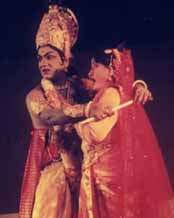Andhrula Janapada and Padya Nataka Vaishisyam

Andhrula Janapada and Padya Nataka Vaishisyam is an event that took place on 03-Nov-2000 in Hyderabad.
-
Venue
-
Date/Time
-
Type
-
Price
-
Add New Field:
It's a rare and delightful occasion when folk rhythms, street plays and songs reverberate for an urban audience. And the lucky few visitors to Necklace Road today, the third day of the week-long festival, happened to see the vanishing forms of street performances like "Oggu Katha", "Chindu Bhagavatham", "Janapada Geetalu" and a "Pouranika Natakam" (popular mythological theater).
"Amma Baillelinado Nayano Talli Baillelinado" with a jerky swing, by Chalapati Rao and N Ganesh Rao, set the mood with some folk hits of Telangana. This was followed by "Oggu Katha", practised by the poorest of artists from the lower classes for the poor slum dwelling audience of Bhuvanagiri, Nalgonda region, and carried that typical local accent and generic attitude of dialogues. Two lead performers donned as Siva and Parvathi appeared on stage backed by a group of percussionists.
"Srisailam Mallikarjuna Swami" was an interesting theme that showed the ascetic Siva wandering the jungles of Srisailam - the impression created is that Siva was none other than their ancestor. Bringing such rare street theater as "Oggu Katha" on stage and suddenly patronizing it itself is a gesture of the Tourism Department deserving of genuine appreciation.
"Chindu Bhagavatham", which interests many a performing artist and researcher for its intricate grammatical content, twisted themes and elaborate costume and makeup, and yet comes on stage in a simplistic humble presentation, is another such example. "Chenchu Laxmi" was the chosen theme, and saw Chindula Pedda Shyam and a group of eleven members from Nizamabad.
Lord Narasimha is wandering in the jungles, and confronts a spirited tribal girl Chenchu Laxmi holding a bow and a bunch of arrows(!) - she only falls in love with him, and they get married in the jungles. And this leads to a complicated yet funny situation where Narasimha is sandwiched between his original consort Adi Laxmi and the tribal girl.
The artists (all male members) appeared with elaborate ornaments traditionally made of lightwood, and had their faces painted yellow. The tribal women were shown wearing peacock feathers in the crown and around their skirts. With punchy spontaneous dialogues, stretching ends of songs and prose passages, a heart-felt humor and emotion and, above all, artists all at their vibrant best, the play is one to be remembered.
Sri Satya Sai Kala Niketan staged the concluding and the much-hyped play "Sri Krishna Tula Bharam". With flamboyant stage sets, music, lighting, costume, classic rendition of dialogues, songs, action, prose passages and what-not, the painstakingly composed and organized mythological play shows the yesteryear tradition of popular entertainment that gave way to cinema early in the last century. Now, sadly, it is striving hard to survive, with very few practitioners. Again the tourism department has to be credited for (though late) beginning to patronize the art. And it will hopefully not take too long to attract audiences.
This popular theme shows Krishna amidst his consorts Rukmini, the embodiment of love and respect, and Satya Bhama with her possessive love. Gummadi Gopala Krishna as Krishna and Tenali Shakuntala and Surabhi Jamuna Rayalu as the two consorts made a perfect dramatic trio, and Kanakambaram played the bouncy role of the catalyst Sage Narada. This two and a half hour play saw the audience glued to their seats till 10.30 in the night.
Be the first to comment on Andhrula Janapada and Padya Nataka Vaishisyam! Just use the simple form below.
LEAVE A COMMENT
fullhyd.com has 700,000+ monthly visits. Tell Hyderabad what you feel about Andhrula Janapada and Padya Nataka Vaishisyam!
MORE EVENTS IN THIS PERIOD
ALL EVENT CATEGORIES
SEARCH EVENTS
Dissatisfied with the results? Report a problem or error, or add a listing.
ADVERTISEMENT
SHOUTBOX!
{{ todo.summary }}... expand »
{{ todo.text }}
« collapse
First | Prev |
1 2 3
{{current_page-1}} {{current_page}} {{current_page+1}}
{{last_page-2}} {{last_page-1}} {{last_page}}
| Next | Last
{{todos[0].name}}
{{todos[0].text}}
ADVERTISEMENT
This page was tagged for
piyush japada
pouranika geethalu
Janapada geetalu even an original or audio song come
pouranika arnuments in Hyd
sri krishna chenchu lakshmi janapada geethalu